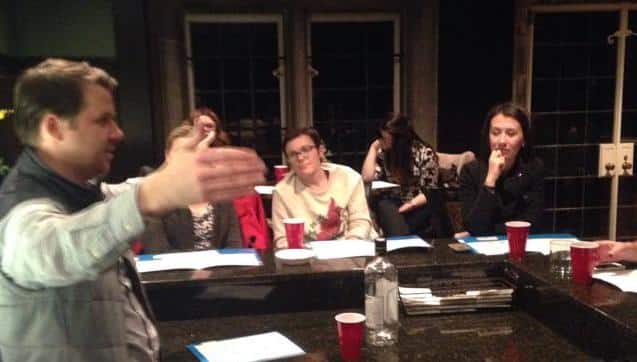HVAC Acronyms and Other Topics With Girls Pint Out
Last week, I had the privilege to host an event at Laurel Hall for a fun and engaging group of women in the organization Girls Pint Out. If you’re unfamiliar, it is a national craft beer organization for women, whose mission is to build a community of women who love craft beer and who are an active, contributing part of the greater craft beer community. We spent around 2 hours enjoying some quality beer and having an engaging conversation about a number of topics, including Nest thermostats, heat pumps, HVAC acronyms and diets.
What I found out is that these “girls” are pretty fantastic women. And they’re not just discerning about their beer, but about life in general. They asked some pretty great questions about heating and cooling, and so I thought I’d share some of the Q&A we had, in case it can help some other discerning customer make better decisions in the future. *Full disclosure, I also had beer, so please excuse any inaccuracies in my memory, ladies.
Q: What does the HVAC acronyms stand for?
A: HVAC stands for Heating, Ventilating and Air Conditioning. The fact that it’s used so prevalently and so few people know what it means is a great metaphor for the industry itself. Confusion in communication is the norm. Using industry shorthand is just another example of this. At Homesense, we really believe helpful and understandable communication, even if it’s not technical, is more meaningful to homeowners. (I also believe that most of the issues in the world could be quickly remedied by outlawing acronyms)
Q: My thermostat says it’s on emergency heat, what does that mean, why does that happen?
A: Emergency heat is associated with heat pump systems. A heat pump has an outdoor condenser that works the same as an air conditioner in the summer, then reverses that process in the winter. When the outdoor temperature drops to a certain point where the heat pump can’t keep up with the heating demands, emergency heat kicks on. In most cases, that’s an electric backup heat (which can be very expensive). In some cases, it is a gas furnace backup heat. More information on heat pumps can be found here.
Q: How can I tell if I have a heat pump or an air conditioner?
A: Almost always if your home is all electric, you will have a heat pump system. This is more common in newer developments since it is expensive to pipe in gas. A telltale sign that you do have a heat pump is that your outdoor system sits off the ground, many times with plastic or wooden “pump ups”.
Q: My filter doesn’t look like a normal paper one, it has metal instead. What is that?
A: Typically when there is metal where a filter usually goes, that is called an electrostatic filter. And it functions just as the name suggests. This metal is electrically charged, and uses static to filter the air, in a similar way that the paper filters removed dust from the air. Increasingly, the top air purifiers are incorporating both paper and electrostatic to clean the air.
Q: What do you think about things like the Nest thermostat?
A: I think the Nest is a beautifully designed thermostat, that can be very beneficial for some applications. I personally believe the best thing Nest has done is to push the industry to realize that there’s an end user at all the stuff that’s created. By Nest going around the conventional marketing and distribution apparatus, and been largely successful at it, the big players in the industry that have great engineering and technology capabilities to bring to the table, are now using those to play catch up to Nest.
In between those questions we talked about plenty of fun, but non relevant topics, including how Chelsea FC is far superior than Liverpool FC, how video gaming is actually a sport in other countries, and Eaven’s carb free diet.
As always, if you have any questions about HVAC acronyms, give me a shout here or on Twitter @TrustHomesense.
